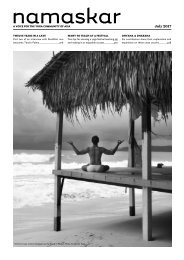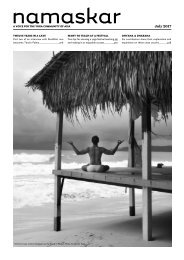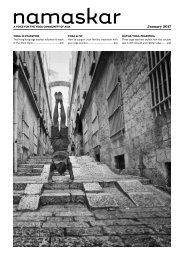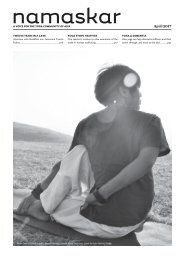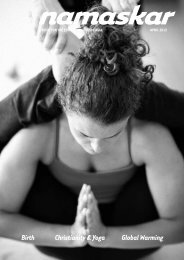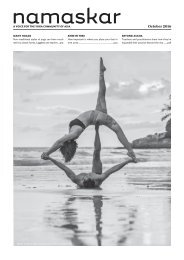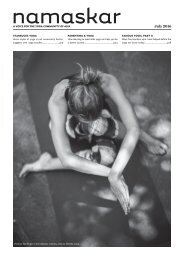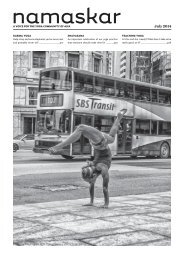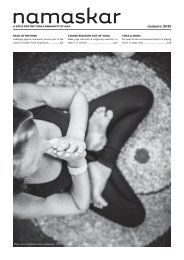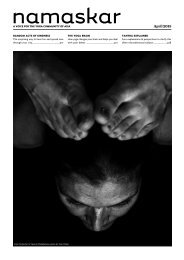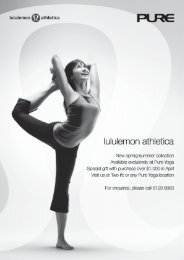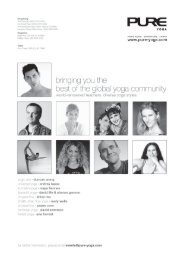Namaskar - Oct 09
Create successful ePaper yourself
Turn your PDF publications into a flip-book with our unique Google optimized e-Paper software.
Workshop Review<br />
A journey into Anatom<br />
omy – with Paul and Suz<br />
uzee Grilley<br />
Rani Kamaruddin<br />
In this, the first of a two-part<br />
workshop review, Rani<br />
introduces readers to the<br />
anatomy of yoga as taught by<br />
Paul and Suzee Grilley at True<br />
Yoga in Singapore 25 th - 30 th<br />
September. Part two - “Yin<br />
Yoga: Theory & Practice” will<br />
follow in the next issue.<br />
PAUL & SUZEE GRILLEY<br />
As glossy pictures of asanas fill<br />
pages of yoga magazines, the<br />
descriptive annotations to them<br />
ease the visualization of how a<br />
pose should ‘look’ like. These<br />
aesthetic descriptions (with or<br />
without the pictures) are often<br />
mistaken as a standard of<br />
achievement, the norm for<br />
posture alignment or a<br />
measurement of the right and<br />
wrong of a shape. It presents a<br />
picture-perfect pretzelicious<br />
pose, but rarely pays attention to<br />
the functional purpose of the<br />
pose or the anatomical range of<br />
motions for each unique and<br />
individual body, as is<br />
predetermined in the womb.<br />
To understand the functional<br />
purpose of a pose, we must<br />
understand the anatomical range<br />
of motion. At the workshop we<br />
learned the anatomical range of<br />
motions can be analyzed<br />
through 14 body segments.<br />
Each segment is limited by a<br />
number of possible<br />
movements. While there are<br />
numerous yoga poses and<br />
variations, all poses find their<br />
functional purpose in these<br />
segments, one at a time, or<br />
combined.<br />
The 14 segments are scapula,<br />
humerus, ulna, radius, wrist,<br />
fingers, cervical, thorax, lumbar,<br />
pelvis, femur, tibia, ankle and<br />
toes.<br />
Paul took a pragmatic approach<br />
to analysing the range of<br />
motions in each of these<br />
segments by having us<br />
experiment with each other to<br />
feel at which point the<br />
compression of the bones<br />
started to limit the range of<br />
motion. Many times I wished<br />
for super x-ray glasses so I could<br />
look through my partner’s skin<br />
and muscles and recognise her<br />
body as a walking skeleton!<br />
It’s not so much about<br />
someone’s persistence, wanting<br />
to go beyond the edges,<br />
stamina, focus, ability to endure<br />
pain, taking a deeper breath or<br />
number of years of practice that<br />
determines whether the person<br />
can do a pose or not; it is the<br />
compression of the bones and<br />
tension in the muscles that limit<br />
the range of motion. These<br />
experiments certainly peeled<br />
away the layers of concepts of<br />
how a pose should be aligned or<br />
whether a pose is advanced.<br />
Take, for instance, seated spinal<br />
twist (ardha matsyendrasana). The<br />
placement of the arm has<br />
nothing to do with the degree<br />
of the twist itself. Whether or<br />
not the elbow could be placed<br />
against the outer edge of the<br />
knee had to do with how much<br />
the femur could adduct, the<br />
more the knee could move<br />
across the midline of the torso,<br />
the easier it is for the person to<br />
place the elbow against the outer<br />
edge of the knee. Neither did it<br />
matter if the placement of the<br />
foot was closer to the buttocks<br />
or further away, right next to the<br />
straight leg or slightly away from<br />
it. The straight leg and the foot<br />
on the leg that is bent serve the<br />
purpose of anchoring. The arm<br />
serves as leverage to twist the<br />
thoracic spine. The limbs are<br />
completely of secondary<br />
importance. The functional<br />
target of the twist is the thoracic<br />
spine. How deep the twist is, is<br />
a measurement of the thoracic<br />
spine relative to the pelvis, not<br />
to the floor, the edges of the<br />
mat, or the placement of the<br />
limbs. One student who could<br />
not bring her knee across the<br />
midline of her torso (as a result<br />
she wrapped her arm around her<br />
knee to pull it into her chest),<br />
had a twist of 75 degrees.<br />
Another student who, from<br />
appearance looked to have a<br />
deeper twist (her elbow was<br />
against her knee) had a twist of<br />
70 degrees. The average twist is<br />
70-75 degrees; both students<br />
were average and normal.<br />
Through these experiments,<br />
Paul and Suzee brought us<br />
valuable insights into the<br />
anatomy of yoga and completely<br />
turned the approach we take to<br />
our own yoga practices upside<br />
down. It brought the focus of<br />
the asana practice back to its core:<br />
what functional purpose does a<br />
pose have? Which area in my<br />
body does this pose target? The<br />
functional purpose of a pose<br />
could also be different to each<br />
of us: where someone may use<br />
downward dog to stretch the<br />
hamstrings; someone else may<br />
use it to stretch the spine. If we<br />
work from the basis of looking<br />
at the functional purpose of a<br />
pose, we are able to work<br />
compassionately<br />
in our practice.<br />
Rani is forever<br />
thankful to the<br />
teachers who<br />
introduced her<br />
to yoga.<br />
33



